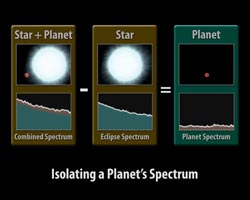Probing exoplanet chemistry without the need for space telescopes

Extraction of an exoplanet spectrum <br>Image: MPIA <br>
The technique can be used by comparatively small telescopes on the ground, making exoplanet chemistry more widely accessible than ever before. First observations have yielded a fundamentally new result about exoplanet atmospheres. The results have been reported in the February 4, 2010 issue of the journal Nature.
Chemical studies of exoplanets – planets that orbit not the Sun, but distant stars – rely on spectroscopy, the systematic study of light emitted, reflected or absorbed by those planets at different colors, or wavelengths. Such studies used to be the domain of space observatories and of the world's largest ground-based telescopes (see the MPIA Science Release 2010-01-13). Now, a new data analysis technique successfully pioneered by a group of astronomers from the US, the UK and Germany has brought exoplanet spectroscopy to a much smaller (and more wide-spread) class of ground-based telescopes.
It took the researchers more than two years to develop their method so that it could be applied to spectroscopic observations of the exoplanet HD 189733b made in 2007 with a 3 metre telescope. Using the new method, the identification of specific molecules such as methane and carbon dioxide became possible. The planet, a gas giant similar to Jupiter, orbits the star HD 189733 A in the constellation Vulpecula (or “Fox”), at a distance of 63 light-years from Earth. The spectrum included an interesting wavelength region that is not observable with current space telescopes.
As seen from Earth, the planet HD 189733b periodically moves behind its host star in a planetary eclipse. The planet's spectrum is extracted by comparing the system's light before and after the star hides the planet from sight. Unfortunately, the same atmospheric turbulence which is responsible for the twinkling of stars in the night sky introduces disturbances that are very difficult to account for. Co-author Jeroen Bouwman of the Max Planck Institute for Astronomy explains: “Using newly developed calibration techniques, we can distinguish the variations in time due to the planetary eclipse from those that are due to atmospheric disturbances, or to instrumental artefacts. In this way, we can tell which part of the light is from the exoplanet, and which from the star.” Previously, this kind of measurement had only been possible with space telescopes, where observing time is rationed out very strictly. Now, exoplanet spectroscopy becomes accessible to dozens of ground-based telescopes with mirror sizes down to a few metres, and without the need for specialized spectrographic equipment.
The study's lead author, Mark Swain from NASA's Jet Propulsion Laboratory (a former guest scientists of the Max Planck Institute for Astronomy) explains further: “The fact that we have used a relatively small, ground-based telescope is exciting because it implies that the largest telescopes on the ground, using this technique, may be able to characterize terrestrial exoplanet targets.” The chemical study of terrestrial, or Earth-like, planets, will be a key step in the search for exoplanets with habitable conditions, or even life on other planets – a crucial, if long-term, aim of modern astronomy. Co-author and MPIA director Thomas Henning adds: “This is exciting news for new instruments such as the LUCIFER spectrograph being installed at the Large Binocular Telescope in Arizona.”
The first measurements using the new techniques provide key data to those modelling exoplanet atmospheres. Previous models were simplified in that they admitted only comparatively slow changes in atmospheric conditions. Researchers knew this to be unrealistic, but did not have sufficient data to distinguish between those overly simplified models and more realistic ones. The new spectroscopic data allows for just such differentiation, allowing astronomers to develop new, more realistic models of exoplanet atmospheres.
Contact
Dr. Jeroen Bouwman (Coauthor)
Max Planck Institute for Astronomy, Heidelberg, Germany
Phone: (0|+49) 6221 – 528 404
E-mail: bouwman@mpia.de
Dr. Markus Pössel (PR)
Max Planck Institute for Astronomy, Heidelberg, Germany
Phone: (0|+49) 6221 – 528 261
E-mail: poessel@mpia.de
Media Contact
More Information:
http://www.mpia.deAll latest news from the category: Physics and Astronomy
This area deals with the fundamental laws and building blocks of nature and how they interact, the properties and the behavior of matter, and research into space and time and their structures.
innovations-report provides in-depth reports and articles on subjects such as astrophysics, laser technologies, nuclear, quantum, particle and solid-state physics, nanotechnologies, planetary research and findings (Mars, Venus) and developments related to the Hubble Telescope.
Newest articles

Bringing bio-inspired robots to life
Nebraska researcher Eric Markvicka gets NSF CAREER Award to pursue manufacture of novel materials for soft robotics and stretchable electronics. Engineers are increasingly eager to develop robots that mimic the…

Bella moths use poison to attract mates
Scientists are closer to finding out how. Pyrrolizidine alkaloids are as bitter and toxic as they are hard to pronounce. They’re produced by several different types of plants and are…

AI tool creates ‘synthetic’ images of cells
…for enhanced microscopy analysis. Observing individual cells through microscopes can reveal a range of important cell biological phenomena that frequently play a role in human diseases, but the process of…





















